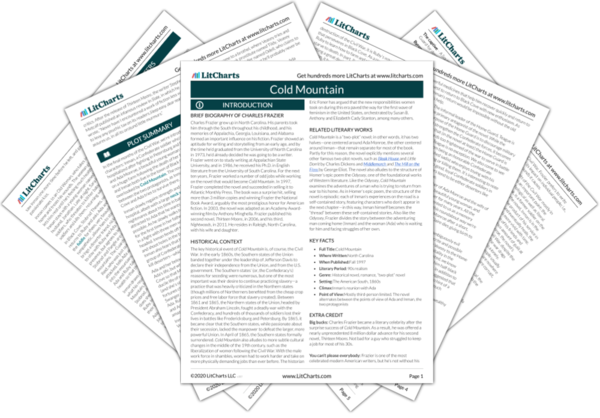Summary
Analysis
Ruby wakes up early to cook eggs for herself and Ada. As she cooks, she notices a man standing outside. She gets her gun and runs out. The man, she can see, is very well dressed, and looks surprisingly casual. Suddenly, Ruby realizes who she’s looking at: it’s Stobrod, her father. Amazed, Ruby asks Stobrod how old he is, and he says that he’s 45. Ruby accuses her father of being a deserter. Stobrod denies this and claims he’s a war hero.
This is our second introduction to Stobrod (previously we’d been told that he’s a bad father to Ruby). The fact that Stobrod is a deserter in and of itself proves nothing—as we’ve seen with Inman, this certainly doesn’t make him a bad person—but the fact that Stobrod lies about it suggests that his desertion stems from fear more than principle.
Themes
Reluctantly, Ruby lets Stobrod into the house for some coffee. She tells Ada that they’ll feed him and then send him on his way. Inside, Stobrod tells Ruby that he’s living with a group of “freewill” people, who drink and roam instead of settling in any single place. Ruby doesn’t pay close attention to Stobrod. After he finishes his coffee and eggs, she sends him away. Stobrod nods and walks into the distance, not looking back.
In the twilight of the war, Stobrod, just like Inman and Ada, must try to make a new life for himself. The difference is that while Ada and Inman try to tie themselves to a specific place—Black Cove—Stobrod roams. The understated quality of this scene between Stobrod and Ruby is both tragic and a little amusing: we can sense that they have a lot to say to each other, but instead the isolation of the characters from each other continues.
Themes
The next day, Ruby and Ada get to work making molasses. In the afternoon, they sit by their barn and stare off at Cold Mountain. When they walk back to the house, they find Stobrod standing outside, looking in expectantly. Although Ruby wants to send her father away at once, Ada reasons that they have plenty of food for him. At supper, Ada asks Stobrod about his time in battle, but Stobrod says little. He produces a fiddle and plays it for his hosts’ entertainment. He tells Ruby the story of how he made the fiddle: he cut maple branches to make the wooden frame, boiled the wood to bend it into the right shape, carved it carefully, etc. His only remaining task was to kill a rattlesnake to place inside the fiddle. This, Stobrod explains, is a custom for fiddlers—adding a snake’s raddle to the fiddle is considered a sign of good luck, and of an outstanding instrument.
This is a critical section in the chapter, because it creates a new bond between Stobrod, Ruby, and Ada. For the most part, the “marauding” characters in this novel are villainous or threatening—the Home Guardsmen are the perfect examples. And yet Stobrod is a different species altogether, and also seemingly different from his old self as an absent father. Stobrod’s devotion to music—not just playing it, but building the physical instrument—has more in common with Ada’s newfound interest in working her farmland. In short, Stobrod isn’t as loutish and lazy as he seemed at first: he has a genuine passion, something that gives his life meaning.
Themes
Stobrod explains how he came to be so interested in fiddling (Ruby points out that before the war he played the fiddle, but showed no great passion for it). In 1862, Stobrod was stationed in Richmond. There, he was sent to play the fiddle for a girl who was dying, and whose last wish was to hear fiddle music. He played six tunes for the girl—the only six tunes he knew. When he was finished, the girl demanded more music, and Stobrod was forced to admit he didn’t know anything else. The girl asked Stobrod to improvise a tune for her, and Stobrod proceeded to try. The tune he invented was so horrible that the girl’s mother cried to hear it. Surprisingly, the girl liked the tune—she told him it was nice, just before dying. For a long time afterwards, Stobrod only played his improvised tune on the fiddle. He gradually learned more about fiddling by spending time with black fiddlers. Now, he knows some 900 tunes.
Frazier humanizes Stobrod by giving Stobrod a backstory, and a tragic one at that. Whatever Stobrod’s failures as a father, he’s clearly capable of emotions like guilt, empathy, and compassion. It’s no coincidence that the dying young girl—arguably a stand-in for Stobrod’s own daughter, Ruby—is the one who compels Stobrod to keep fiddling. One could interpret his fiddling as a kind of displaced apology, not just to the little girl but to Ruby, as well.
Themes
Get the entire Cold Mountain LitChart as a printable PDF.

Stobrod plays a strange tune called “Green-Eyed Girl” for Ada and Ruby. Ruby is amazed that her father shows so much talent for the fiddle. She remembers how he got his nickname long ago—he stole a ham, and was beaten in punishment with a stob (stake) as a rod. Ada thinks that Stobrod’s fiddling proves that “no matter what a waste one has made of one’s life, it is ever possible to find some path to redemption, however partial.”
Although Stobrod’s identity—his very name—reflects his loutish, good-for-nothing qualities, he’s trying hard to redeem himself for his past actions. Even if he doesn’t know how to be a good father to Ruby, his fiddling has a recognizably therapeutic and redemptive quality. Ada (herself a pianist) picks up on this, praising Stobrod for trying to better himself through art.
Themes












